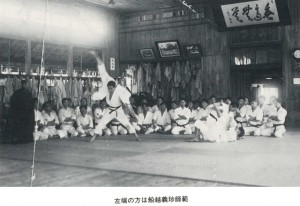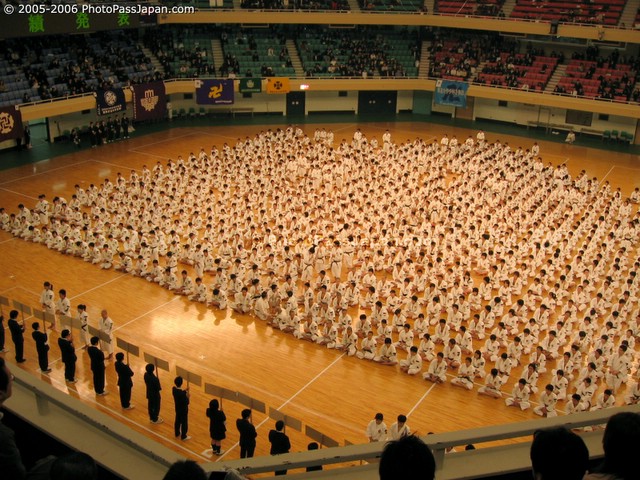Although Karate is mainly a striking, punching and kicking art, it involves joint locks, takedowns, strangulations, throws and a lot more.
So today, lets focus on throws.
Throws (Nage-waza in Japanese) are used/have been used in all fighting cultures around the world, and Karate is no exception.
First of all, why should you use them?
Well, some people think it’s good to use throws if you want to be more “humane”. Maybe you don’t want to gouge his eyes out, or kick him in the groin, so you just throw him down instead! Yes, sometimes it might be more humane, but remember that a person not skilled in falling correctly will get hurt. A throw, in actual combat, is executed in such a way as to crush the opponent’s head or shoulder against the ground. More humane? Maybe not…
I think throws should be used if you want to inflict damage to your opponent (from the fall), while at the same time guaranteeing that he will be down. If you punch or kick, he is not guaranteed to fall down (unless he becomes unconscious from the blow).
If you throw him, he is.
Whatever your reason for throwing is, there are three very important principles in throwing. Of course there are many more, but three stand out. I will tell you about them, but before I do I want to show you this fantastic historic photo of throwing in Karate (for all you doubters out there!).
The photo is from Waseda University, Japan. It was taken at their Karate club in 1935, and the man standing to the far left in black kimono is Funakoshi Gichin, founder of Shotokan-ryu Karate. They even do Ne-waza (ground techniques) to the right! Oh my god, and I thought they only did that in Judo…
Not.
Anyway, let’s get to the title of this post. Top 3 Points of Throwing.
The first point is Kuzushi:
1. Kuzushi.
Kuzushi means to destroy or demolish. Of course we are talking about the balance of the opponent. So step one is simply to upset the balance of the opponent! If this fails, don’t bother with the other two steps. Kuzushi is critical for achieveing success in throwing. So how can you destroy the balance? Well, basically by pushing and pulling. Or by combining them, which we would call twisting. If we don’t want to grab the opponent just yet, we can also take away the balance with atemi (a blow). A sharp knee to the groin, stomp to the knee/fot or a slap to the face should do the trick. As long as you destroy the balance.
Now, maybe you are asking yourself “how does a slap to the face upset the balance of the opponent?”. I agree it can sound silly, but it gives him/her something else to think about, and when the mind is not focused on balancing, taking it away is not that hard anymore…
But remember, sometimes you don’t even have to do anything yourself. Not many people are perfectly balanced to begin with. As long as the weight is not 50/50, you have achieved kuzushi. Success.
2. Irimi
Irimi means entering. In this case we are entering the zone of the opponent. The exact same zone we just removed the balance from. We simply substitute the opponents balance with our own, which (hopefully) is under control. Irimi, entering, is the most dangerous of the three steps, since you are now officially in enemy territory. If your kuzushi failed you will feel it! irimi means you will not have perfect balance either for a split secnd, so a wise opponent may fake bad balance to exploit your irimi-movement.
However, when (if) you have succesfully entered, to your chosen spot, only one step is left.
3. Kake
Kake means execution. The third and final step is to execute the throw.
If you have successfully done Kuzushi and Irimi, then Kake should flow almost by itself. Of course there are people who jump to this step immediately. Because of their sheer strenght, or size, they don’t need any other steps! And this works great until they meet someone who is not a beginner, or not afraid. Or not smaller. So please, don’t jump any steps.
If you fail a step, retreat, and try again. Maybe from another angle. Or change tactic.
And as always when I make lists, I like to flip everything. How do we use the three steps to defend against a throw? It’s simple.
Kuzushi: Always try to have good balance. A bad position is the first step to defeat. Be aware of your two “kuzushi-spots” (tip of the triangel formed by the feet, front and back). Don’t be manipulated.
Irimi: Never let the opponent take your space. Use Tai-sabaki (body movement) and Ma-ai (distance) wisely.
Kake: if you failed both previous steps, and the opponent is a split second away from executing the throw, do everything you can!
Kick, punch, flap like a fish, spin around, scream!
And lastly… stand up before the opponent comes falling down too!
Or use Ne-waza, like in they did in 1935!




4 Comments